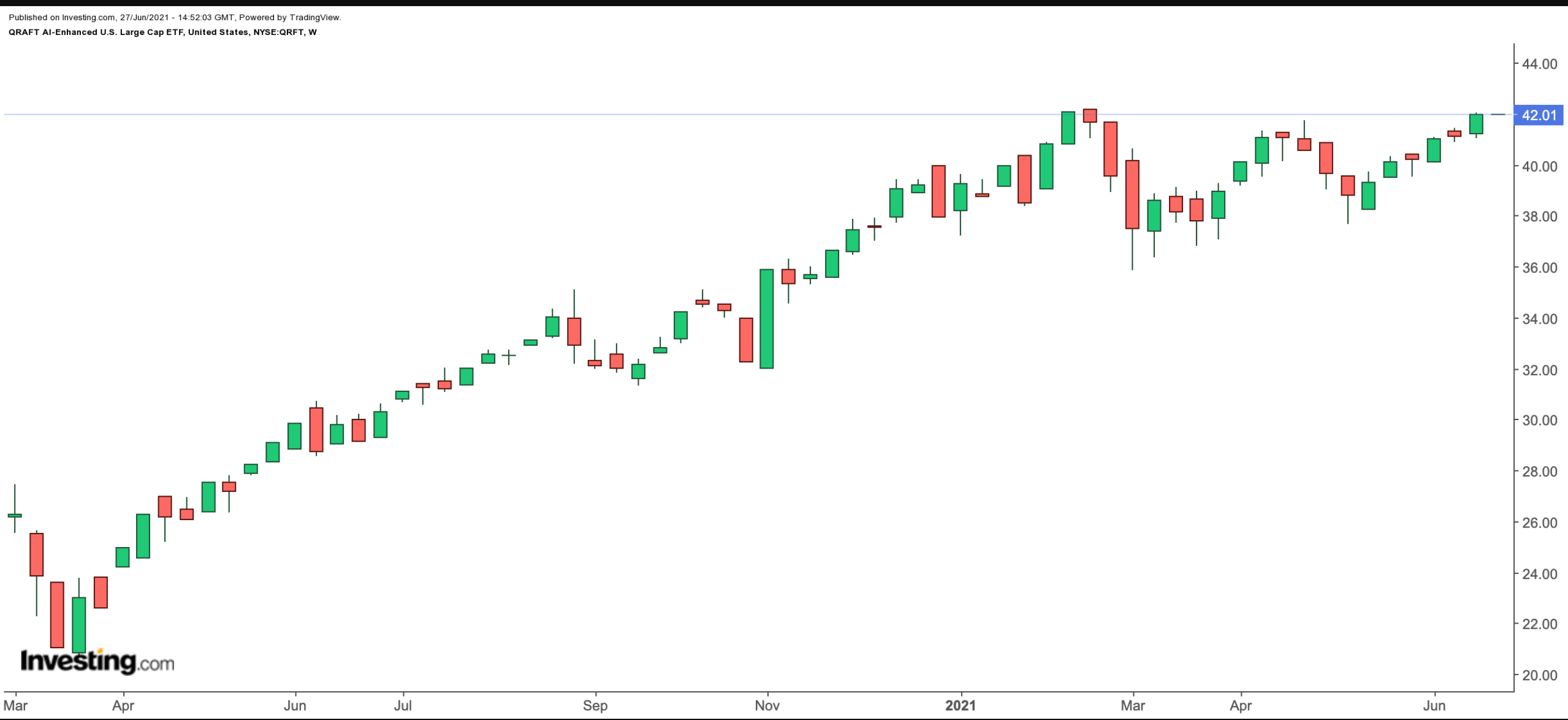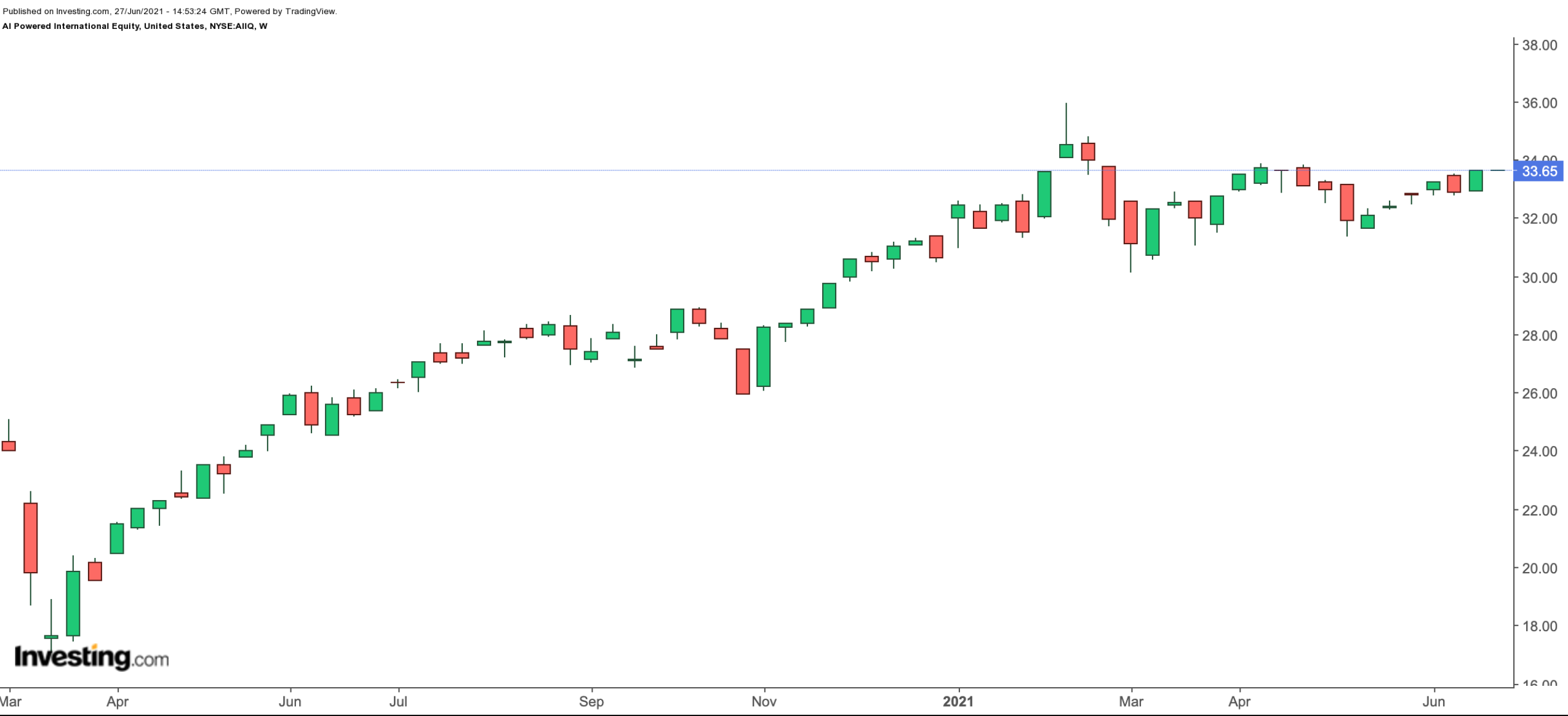Many on Wall Street are keen to invest in cutting edge, emerging technologies such as Artificial Intelligence (AI), which “enables computers and machines to mimic the perception, learning, problem-solving, and decision-making capabilities of the human mind,” according to International Business Machines (NYSE:IBM).
AI and machine learning are fast entering asset and risk management as well as trading. Leading global banks such as Goldman Sachs (NYSE:GS), JPMorgan Chase (NYSE:JPM) and Morgan Stanley (NYSE:MS) have been focusing on these new technologies to improve performance and achieve superior returns. The full potential of AI in finance and investment management is still to be explored.
We previously discussed exchange-traded funds (ETFs) that invest in companies specialising in different aspects of this new technology (covered here, here and here). Today, we expand the discussion to ETFs that rely on AI for investing decisions.
Research on such funds by Jacques Saint-Pierre of Laval University, Canada, points out, that AI “is able to constantly learn based on new financial information it should theoretically improve as time goes on.” Therefore, potential readers who want to add AI-powered products to their portfolios might want to do further due diligence on these ETFs.
1. QRAFT AI-Enhanced U.S. Large Cap ETF
- Current Price: $42.01
- 52-Week Range: $29.15 – $42.22
- Dividend Yield: N/A
- Expense Ratio: 0.75% per year

Our first artificial-intelligence-driven ETF is the QRAFT AI-Enhanced U.S. Large Cap ETF (NYSE:QRFT), launched in May 2019 by South Korean asset manager Qraft Technologies. The fund uses a proprietary AI system to invest in U.S. large-capitalization (cap) firms. The five main factors behind the selection process are quality, size, valuation, momentum, and low risk.
The AI aims to outperform the benchmark that tracks the S&P 500 TR index, which is close to 15% year-to-date (YTD). The actively managed fund primarily seeks capital appreciation.
The fund currently has 351 holdings, and the top ten holdings comprise 20.3% of net assets of almost $20 million. In other words it is a small fund. Information technology (IT) has the largest slice with 43.38%, followed by health care (25.02%), consumer discretionary (9.34%), communication services (7.63) and industrials (6.34%).
Among the leading names in the roster are tech giants Amazon.com (NASDAQ:AMZN), Apple (NASDAQ:AAPL), Microsoft (NASDAQ:MSFT) and Alphabet Class A (NASDAQ:GOOGL) as well as web development platform Wix.com (NASDAQ:WIX).
Year-to-date, the ETF has returned more than 10.5%. In other words, it has not outperformed the benchmark index so far in the year. Artificial intelligence is expected to learn from past performance. Thus the fund could be able to navigate the moves in the broader market adeptly and improve results in the future. Interested investors might want to keep QRFT on their radar.
2. AI Powered International Equity ETF
- Current Price: $33.65
- 52-Week Range: $25.15 – $35.97
- Dividend Yield: 1.23%
- Expense Ratio: 0.79% per year

Our second fund, the AI Powered International Equity ETF (NYSE:AIIQ), relies on AI for investing in global equities that are likely to appreciate in value over the next twelve months. The fund uses IBM’s Watson Artificial Intelligence, “a cognitive computing platform capable of answering natural language questions by connecting large amounts of data.” Data processed includes vast amounts of daily social media entries, sentiment, market signals, and financial metrics.
AIIQ, which has 95 stocks, was first listed in June 2018. Top sectors include IT (12%), health care (9%), and materials (6%). In terms of country exposure, Canada leads the roster with 24%, followed by Japan (16%), Germany (12%), Britain (8%), and Israel (7%).
The leading 10 holdings currently comprise 30% of the fund’s net assets, which is close to $11.7 million. Put another way, AIIQ is also a small fund.
Team-collaboration software platform Atlassian (NASDAQ:TEAM), digital music-streaming group Spotify Technology (NYSE:SPOT), gene-editing company CRISPR Therapeutics (NASDAQ:CRSP), web development platform Wix.com, and cybersecurity name Cyberark Software (NASDAQ:CYBR) top the list of current holdings.
So far this year, AIIQ is up about 9.8% and has returned 31.83% in the past 52 weeks. We’re likely to hear more about AI-powered funds in the coming quarters, and would recommend investors keep them on their watchlist.
Which stock should you buy in your very next trade?
With valuations skyrocketing in 2024, many investors are uneasy putting more money into stocks. Unsure where to invest next? Get access to our proven portfolios and discover high-potential opportunities.
In 2024 alone, ProPicks AI identified 2 stocks that surged over 150%, 4 additional stocks that leaped over 30%, and 3 more that climbed over 25%. That's an impressive track record.
With portfolios tailored for Dow stocks, S&P stocks, Tech stocks, and Mid Cap stocks, you can explore various wealth-building strategies.


